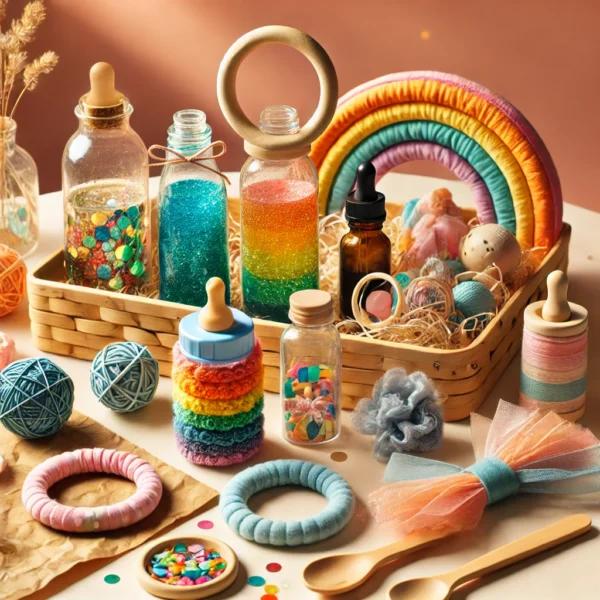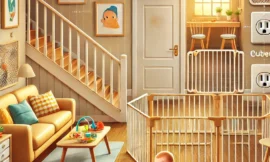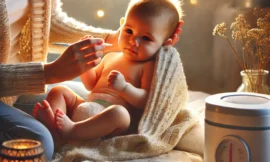Creative Play: DIY Baby Toys and Activities for Fun and Development

DIY baby toys and activities are a fantastic way to engage your baby, stimulate their senses, and support their cognitive and motor development—all without breaking the bank. Here’s a guide on creating safe, enjoyable, and developmentally beneficial DIY toys and activities for babies:
1. Benefits of DIY Baby Toys
- Cost-Effective: Many DIY toys use household items, saving money on store-bought toys.
- Customizable: You can tailor toys and activities to your baby's developmental stage, preferences, and safety needs.
- Encourages Creativity and Exploration: Homemade toys often encourage curiosity and problem-solving as babies explore new shapes, textures, and colors.
2. Essential Safety Tips
- Non-Toxic Materials: Use baby-safe, non-toxic materials and check for small parts that could be choking hazards.
- Sturdy Construction: Ensure DIY toys are well-assembled and able to withstand chewing, pulling, and shaking.
- Supervision: Always supervise play, especially with new toys or activities, to ensure safety.
3. DIY Toy and Activity Ideas by Developmental Stage
Newborn to 3 Months
- High-Contrast Cards: Create simple black-and-white or brightly colored shapes on index cards. Babies at this age are drawn to high-contrast visuals, which help develop focus and visual tracking.
- Sensory Bottles: Fill small plastic bottles with water, glitter, or small colorful objects. These “shaker” bottles provide visual and auditory stimulation and can be safely explored under supervision.
- Crinkle Paper: Use clean wrapping paper or fabric with a crinkly texture inside a small cloth or sensory bag. Babies enjoy the sound and sensation, which helps with auditory development.
3–6 Months
- Tummy Time Mirror: Place a non-breakable mirror on the floor to encourage your baby during tummy time. Babies are intrigued by reflections, which promotes neck and shoulder muscle development.
- Fabric Ribbons and Scarves: Attach colorful ribbons to a secure ring or hoop, or use soft scarves for a fun peek-a-boo game. This helps develop fine motor skills as babies grasp and explore different textures.
- Stuffed Sock Animals: Fill a clean sock with cotton or soft materials, draw a simple face with non-toxic markers, and tie it closed. These “sock animals” are easy to grip and fun to chew.
6–12 Months
- Treasure Baskets: Create baskets filled with safe household items like wooden spoons, soft fabric pieces, or plastic cups. Babies love exploring different textures, shapes, and colors, helping develop their senses and hand-eye coordination.
- Homemade Shakers: Fill small containers with rice, beans, or pasta, and secure the lids tightly. Shakers help babies develop rhythm and sensory awareness through sound.
- Obstacle Course: Use cushions, blankets, and pillows to create a soft obstacle course. Encouraging your baby to crawl or roll over these “obstacles” strengthens their gross motor skills and coordination.
12 Months and Older
- DIY Shape Sorters: Cut holes in the lid of a sturdy container and provide large, colored shapes (such as big blocks or foam pieces) that fit the holes. Shape sorters enhance problem-solving and fine motor skills.
- Push and Pull Toys: Attach a string to a light container or toy, turning it into a pull toy. Babies enjoy the cause-and-effect experience of pulling an object, which builds coordination.
- Water Play Station: Fill a shallow container with water and a few safe toys, like floating rubber animals or cups. Supervised water play is refreshing and teaches concepts of pouring, splashing, and water movement.
4. Engaging DIY Activities
- Sensory Bag: Fill a resealable bag with items like water, glitter, food coloring, and small waterproof toys. Tape the bag shut and let your baby squish and explore the textures.
- Bubble Wrap Play: Place a sheet of bubble wrap on the floor for babies to crawl or walk over. The sensation of popping bubbles is exciting for them and promotes sensory development.
- Paint-Free Art: Place a piece of paper with blobs of non-toxic paint inside a sealed plastic bag, then tape it down on a surface. Babies can press and squish to move the paint around without getting messy, creating colorful designs.
5. Benefits of DIY Activities for Development
- Sensory Exploration: DIY toys and activities expose babies to different textures, sounds, and visuals, helping develop sensory processing skills.
- Motor Skill Development: Activities that encourage grasping, reaching, and crawling help strengthen both fine and gross motor skills.
- Problem Solving and Creativity: Many DIY activities encourage experimentation, teaching babies cause-and-effect and encouraging curiosity.



